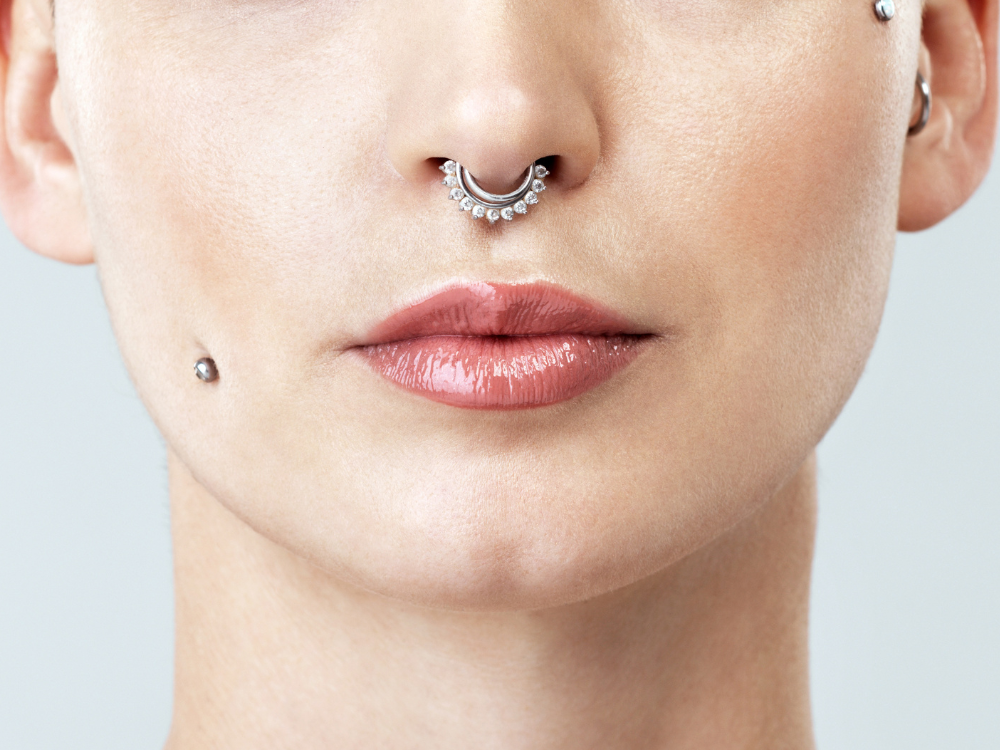
Unlike traditional piercings, which go in one side and exit another, a dermal piercing is a single-point surface piercing. Instead of passing through the skin completely, dermals sit embedded within the dermis layer, anchored securely in place. If you’re wondering what is a dermal piercing, it’s essentially a piece of jewelry held by a flat, T-shaped base under the skin. This unique method makes dermals visually striking but also more challenging to care for compared to standard piercings.
How Do Dermal Piercings Work?
A dermal anchor piercing involves inserting a small anchor beneath the skin’s surface. The jewelry’s decorative top remains visible while the anchor holds it firmly in place underneath. Because the anchor sits under the skin, how do dermal piercings work differently? Unlike earrings or nose studs, dermal face piercings don’t have a traditional back or exit point. Thus, dermals require extra care to prevent infections, shifting, or rejection by the body. Furthermore, dermals piercing areas like the cheeks, chest, or neck can easily snag on clothing or hair, leading to complications.
Types of Dermal Piercings
There are several types of dermal piercings depending on placement and jewelry style. Popular options include: Neck dermal piercing, Dermal facial piercing, Chest dermals and Back dermals. Each area offers a unique look but may vary in healing time and maintenance needs. Meanwhile, a subdermal piercing refers to larger implants placed fully under the skin, a more extreme body modification.
Challenges of Removing a Dermal Piercing
The tricky part comes when someone with a dermal piercing decides they want it removed. Unlike earrings, you can’t just unscrew the back and slide it out easily. First, the decorative top must be unscrewed carefully. Next, the anchor which features a T-shaped base must be extracted from the dermis. Yanking the anchor out is extremely risky and can cause major skin damage or scarring.
Thus, safe removal requires a small incision over the arms of the anchor. This process ensures the anchor comes out smoothly, without tearing healthy skin tissue. Attempting DIY removal is dangerous and often leads to infection, scarring, or incomplete extraction.
Why You Should Seek Professional Removal
If you’re considering removing a dermal facial piercing or any dermals piercing, always consult a medical professional. Professionals use sterile tools and controlled techniques to minimize trauma and promote clean healing. At McLean Dermatology & Skincare Center, we specialize in safe, efficient dermal piercing removal with minimal scarring. Our expert team ensures the area heals properly to maintain your skin’s health and appearance.
Things to Consider Before Getting a Dermal Piercing
While we are not telling you to cancel your next piercing appointment, some risks are worth considering.
Think carefully about:
- How you’ll care for the piercing
- Whether you’ll keep it long-term
- The potential challenges if you decide to remove it later
Day-to-day care for dermals includes regular cleaning, avoiding tugging, and watching for signs of infection. Moreover, understanding what a dermal piercing is ahead of time prepares you for the maintenance and lifestyle adjustments required.
Can You Remove a Dermal Piercing at Home?
Technically, you might find DIY tutorials online but please don’t attempt it. Removing a dermal anchor piercing incorrectly can cause severe skin trauma, infections, and even permanent scarring. Therefore, always trust trained professionals who know how do dermal piercings work beneath the surface.
Our office uses precise, minimally invasive methods to ensure the safest outcome possible.
Common Issues with Dermals
Common complications include:
- Infection around the piercing site
- Anchor rejection (your body pushes the anchor out)
- Jewelry shifting or tilting under the skin
- Tearing or pulling from clothing or hair
Particularly with a neck dermal piercing, accidental snags are frequent due to shirt collars, scarves, and necklaces. Daily vigilance and proper aftercare can minimize these risks but can’t eliminate them entirely.
Is a Dermal Piercing Right for You?
Before committing to a dermal piercing, ask yourself:
- Can I commit to daily cleaning?
- Am I okay with the possibility of scars?
- Will my lifestyle or job interfere with healing?
Answering these questions honestly can save you from future regret and frustration. Furthermore, some workplaces may frown upon visible piercings like dermal face piercing placements.
Shop our favorite skincare and more on Derm to Door.com!
Head back to our blog here!


